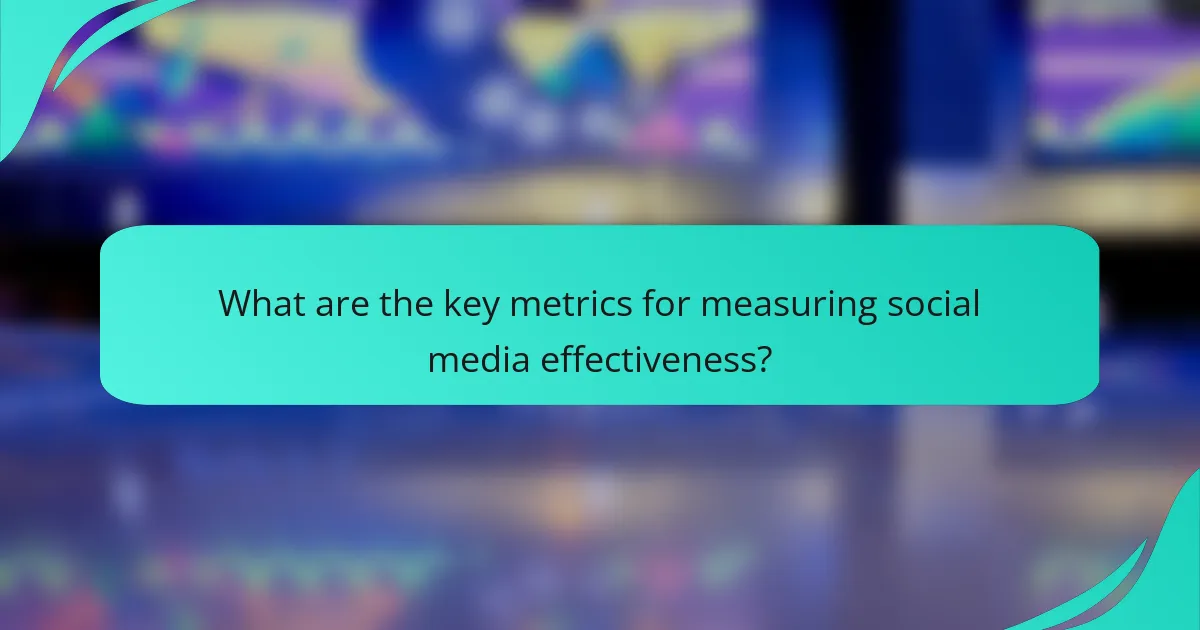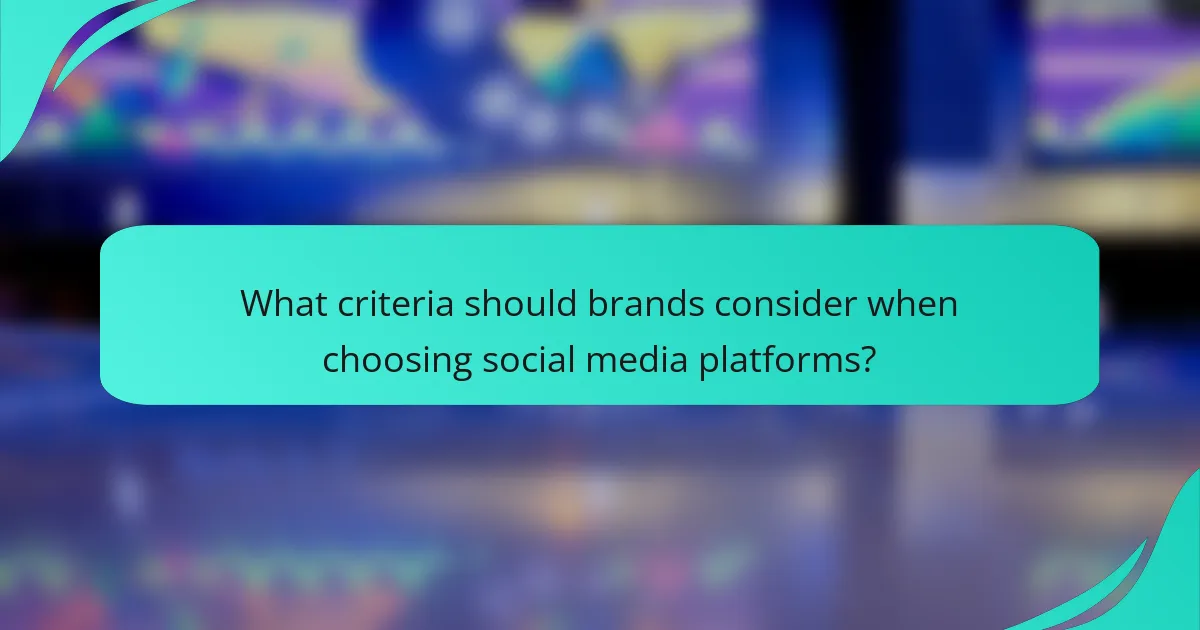Social media has emerged as a crucial tool for brands aiming to connect with their audiences effectively. With billions of active users across platforms like Facebook, Instagram, and Twitter, businesses can utilize targeted advertising to enhance their marketing strategies. Moreover, audience interactions through comments, shares, and direct messages play a vital role in shaping brand perception and fostering customer loyalty.

How effective is social media advertising in the US?
Social media advertising is highly effective in the US, offering brands a powerful platform to reach and engage their target audiences. With billions of users across various platforms, businesses can leverage targeted ads to achieve significant marketing goals.
High ROI for brands
Social media advertising often yields a high return on investment (ROI) for brands, making it an attractive option for marketers. Many businesses report ROI rates that can exceed 100%, especially when campaigns are well-targeted and optimized.
To maximize ROI, brands should focus on specific audience segments and utilize analytics to refine their strategies. Testing different ad formats and messages can also help identify the most effective approaches.
Increased brand awareness
Social media advertising significantly boosts brand awareness, allowing companies to reach a broad audience quickly. Ads can be tailored to specific demographics, ensuring that brands are seen by potential customers who are most likely to engage.
Utilizing visually appealing content and clear messaging can enhance visibility. Brands should consider running campaigns that encourage shares and interactions, further amplifying their reach organically.
Enhanced customer engagement
Engagement is a key benefit of social media advertising, as it fosters direct interaction between brands and consumers. Features like comments, shares, and likes enable brands to create a dialogue with their audience, building relationships and loyalty.
To enhance customer engagement, brands should respond promptly to comments and messages, and create content that invites participation, such as polls or contests. Regularly analyzing engagement metrics can help refine strategies for better results.

What is the reach of major social media platforms in North America?
The reach of major social media platforms in North America is substantial, with hundreds of millions of users actively engaging across various networks. Platforms like Facebook, Instagram, and Twitter dominate the landscape, each offering unique demographics and engagement opportunities.
Facebook’s user demographics
Facebook remains one of the largest social media platforms in North America, boasting a diverse user base. Approximately 70% of adults in the U.S. use Facebook, with a significant presence among users aged 25 to 34. This demographic is particularly valuable for businesses targeting young professionals.
In terms of gender, the platform has a relatively balanced user distribution, although slightly more women tend to use Facebook compared to men. Understanding these demographics can help marketers tailor their content and advertising strategies effectively.
Instagram’s audience growth
Instagram has experienced rapid audience growth, particularly among younger users. Over 60% of users are aged 18 to 29, making it an ideal platform for brands targeting millennials and Gen Z. The platform’s visual nature encourages high engagement rates, with users spending an average of 30 minutes per day browsing content.
Businesses can leverage Instagram’s growth by utilizing features like Stories and Reels, which are popular among users. Regularly posting engaging visuals and utilizing hashtags can significantly enhance visibility and interaction with the audience.
Twitter’s engagement statistics
Twitter’s engagement statistics reveal that users are highly active, with over 500 million tweets sent daily. The platform is particularly effective for real-time news and updates, attracting users who seek immediate information. Engagement rates can vary, but tweets with images or videos generally receive more interactions.
Brands can capitalize on Twitter’s fast-paced environment by participating in trending conversations and using relevant hashtags. However, it’s crucial to maintain a consistent posting schedule to keep the audience engaged and informed.

How do audiences interact with brands on social media?
Audiences interact with brands on social media through various channels, primarily comments, direct messages, shares, and user-generated content. These interactions can significantly influence brand perception and customer loyalty.
Comments and direct messages
Comments and direct messages are direct forms of engagement where audiences express their opinions, ask questions, or seek support. Brands should monitor these interactions closely, as they provide valuable feedback and opportunities for personalized communication.
Responding promptly to comments and messages can enhance customer satisfaction and foster a sense of community. Aim to reply within a few hours to maintain engagement and show that you value your audience’s input.
Shares and retweets
Shares and retweets amplify a brand’s reach by allowing users to distribute content within their networks. This organic sharing can lead to increased visibility and new audience segments, making it crucial for brands to create shareable content.
To encourage shares, focus on creating engaging, visually appealing posts that resonate emotionally with your audience. Consider using incentives, like contests or exclusive content, to motivate users to share your posts.
User-generated content
User-generated content (UGC) refers to any content created by consumers that showcases a brand, such as reviews, photos, or videos. UGC can enhance brand authenticity and trust, as potential customers often value peer opinions over traditional advertising.
Brands should actively encourage UGC by creating campaigns that invite users to share their experiences. Highlighting UGC on your official channels can also strengthen community ties and motivate others to contribute.

What are the key metrics for measuring social media effectiveness?
Key metrics for measuring social media effectiveness include engagement rate, conversion rate, and click-through rate. These metrics help businesses evaluate how well their content resonates with audiences and drives desired actions.
Engagement rate
The engagement rate measures how actively users interact with your content, including likes, shares, comments, and reactions. A higher engagement rate indicates that your audience finds your content interesting and relevant.
To calculate engagement rate, divide the total engagements by the total reach or impressions, then multiply by 100 to get a percentage. Aim for an engagement rate of around 1-5% for most platforms, but this can vary by industry.
Common pitfalls include focusing solely on likes instead of overall interactions. Consider using tools to track engagement over time, which can help identify trends and optimize content strategy.
Conversion rate
The conversion rate reflects the percentage of users who take a desired action after engaging with your content, such as signing up for a newsletter or making a purchase. This metric is crucial for assessing the effectiveness of your social media campaigns in driving business goals.
To calculate conversion rate, divide the number of conversions by the total visitors from social media, then multiply by 100. A typical conversion rate ranges from 1-3%, but this can vary significantly based on the industry and the effectiveness of your call-to-action.
To improve conversion rates, ensure that your landing pages are optimized for user experience and that your calls-to-action are clear and compelling. Avoid overloading users with too many options, which can lead to decision fatigue.
Click-through rate
Click-through rate (CTR) measures the percentage of users who click on a link in your social media post compared to the total number of users who viewed the post. A higher CTR indicates that your content is effectively prompting users to take action.
To calculate CTR, divide the number of clicks by the total impressions, then multiply by 100. A good CTR typically falls between 2-5%, depending on the platform and the nature of the content.
To enhance your CTR, use compelling headlines and visuals that attract attention. Avoid vague language and ensure that links are easy to find. Regularly analyze your CTR to identify which types of content perform best and adjust your strategy accordingly.

What criteria should brands consider when choosing social media platforms?
Brands should consider their target audience, the types of content they plan to share, and their advertising budget when selecting social media platforms. These factors will significantly influence the effectiveness and reach of their social media efforts.
Target audience alignment
Understanding the demographics and preferences of your target audience is crucial when choosing social media platforms. Different platforms attract varying age groups, interests, and behaviors. For instance, younger audiences may prefer TikTok or Instagram, while professionals might lean towards LinkedIn.
To ensure alignment, conduct research on where your audience spends their time online. Utilize tools like surveys or analytics to gather insights, and adjust your strategy accordingly to engage effectively with your desired demographic.
Content format suitability
Each social media platform supports different content formats, which can affect your brand’s messaging. For example, Instagram and Pinterest are highly visual, favoring images and videos, while Twitter is text-centric, ideal for concise updates and discussions.
Consider what types of content you can produce consistently. If your strength lies in video production, platforms like YouTube or TikTok may be more suitable. Assessing the compatibility of your content with the platform’s strengths can enhance audience engagement.
Advertising budget
Your advertising budget will play a significant role in determining which social media platforms are viable for your brand. Each platform has different advertising costs, with some offering more affordable options than others. For instance, Facebook and Instagram can provide targeted advertising at various price points, while LinkedIn tends to be more expensive.
Establish a clear budget and consider the potential return on investment for each platform. Start with a small budget to test ads and analyze performance before committing larger amounts. This approach allows you to optimize spending based on what works best for your audience.

How does social media influence consumer behavior?
Social media significantly impacts consumer behavior by shaping perceptions, preferences, and purchasing decisions. It serves as a platform for information sharing, peer influence, and brand engagement, leading to increased consumer awareness and interaction.
Peer recommendations
Peer recommendations on social media can heavily sway consumer choices. When users see friends or influencers endorsing a product, it often creates a sense of trust and credibility, making them more likely to consider that product. For instance, a positive review from a close friend can lead to immediate interest in a product, while negative feedback can deter potential buyers.
To leverage peer recommendations effectively, brands should encourage satisfied customers to share their experiences online. This can be facilitated through incentives, such as discounts or giveaways, for users who post about their purchases. Brands can also create shareable content that prompts users to tag friends, amplifying their reach.
Brand loyalty
Social media plays a crucial role in fostering brand loyalty by enabling direct interaction between brands and consumers. Engaging content, responsive customer service, and personalized communication can strengthen emotional connections, encouraging repeat purchases. Brands that maintain an active social media presence often see higher loyalty rates among their followers.
To build brand loyalty, companies should focus on creating a community around their brand. This can include hosting live Q&A sessions, sharing user-generated content, and responding promptly to comments and messages. Consistency in messaging and values across platforms is also vital to reinforce trust and loyalty among consumers.
